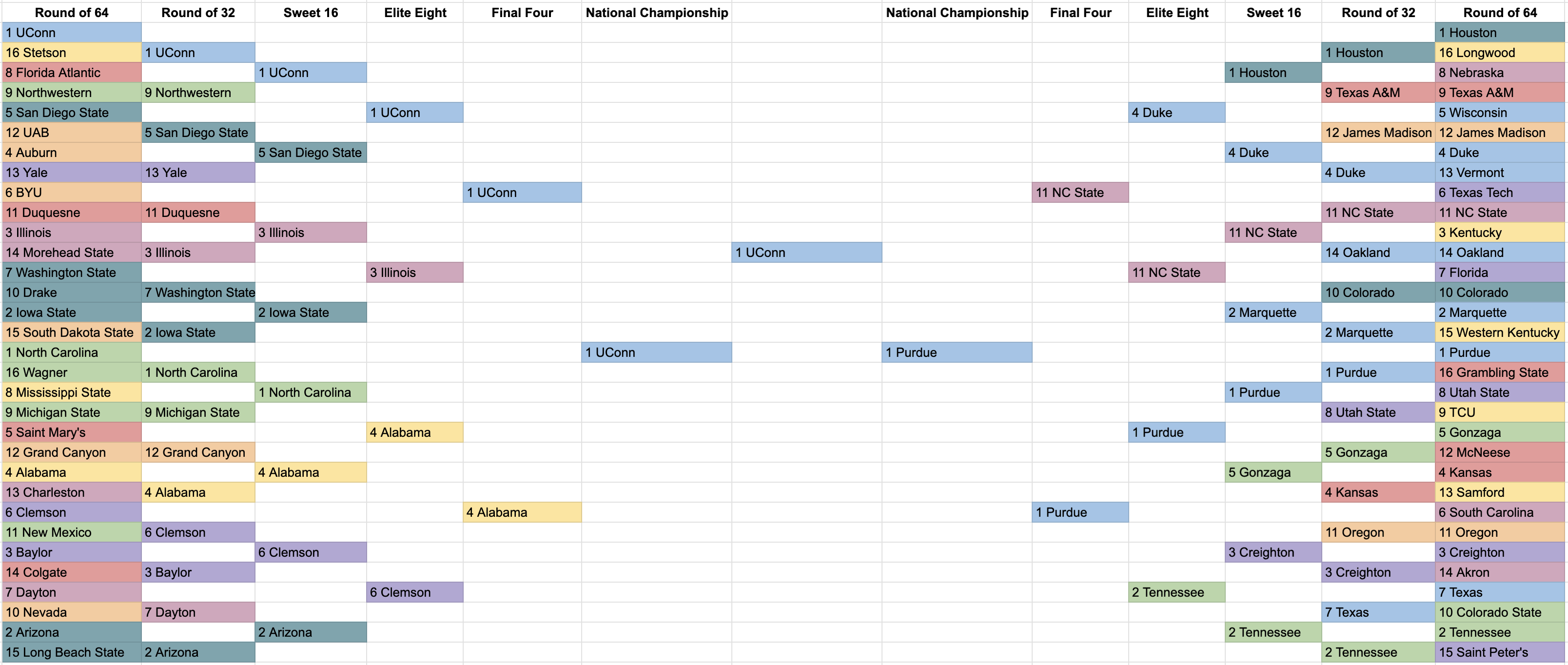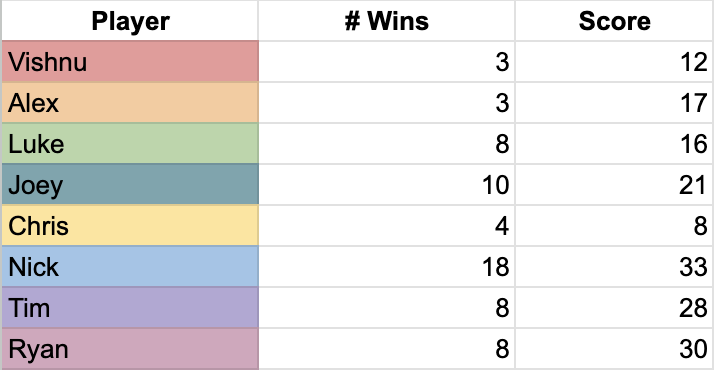March Madness Bracket Draft
The Idea
During the intermission of a watch party for Killers of the Flower Moon, my friend Deg pulled up the Michigan State basketball game to check the score. As we began discussing the game, Big Ten basketball, and our teams’ March Madness hopes, Deg let me know about a March Madness alternative that him and his friends had been playing over the past few years.
Instead of creating a bracket, players drafted teams from the tournament. With 8 participants, each player would end up selecting 8 teams in a snake style draft, similar to fantasy football. Every win a player’s team got would count as one point. The player who received the most points would win half the pot and the player who drafted the team that won the tournament would win the other half.
From the moment Deg explained the rules, I became enamored with the game. It provided a unique twist to the traditional March Madness bracket challenge while adding elements of skill, strategy, and competition that wouldn’t otherwise exist. But as I mulled over the idea, something kept not sitting right with me, that each team only received 1 point per win. Based on the odds of each seed winning, your best strategy would be to draft the next available highest seed. There always are upsets during the tournament, but with the proposed weighting, I felt it wouldn’t be rewarding to use an early pick to predict an upset.
Let’s say you wanted to predict a 14 seed upsetting a 3 seed in the first round. The odds of that happening are very low. Going into the 2024 tournament, 14 seeds had only beaten 3 seeds 22 times in 152 match ups and only two of those 14 seeds have gone on to win another game after the first round [1]. Is it worth drafting a 14 seed, when they aren’t the next highest available seed, when history would tell you to expect one, maybe two, points at most? When the overwhelming likelihood is that you receive zero? My friend Joey made a good point, if each team is weighted equally, then the game turns into a normal bracket challenge where your goal is to pick the teams that go the furthest.
Points
To add an increased element of skill and strategy, I felt there needed to be a way to assign points to each team so that the expected value of picking any team is roughly the same. I talked through a couple different ways with some friends and a common suggestion was to use Vegas odds. Although it was feasible, odds change from sports book to sports book, and it felt like it would add too much variety when trying to select a team. The most balanced solution I landed on was to assign a point value to each seed and make the weighting based on the number of wins that seed earns on average. Using data on the probability of seeds winning each round and the average number of wins all time for each seed, I determined a weight that every seed should receive per win to make the total expected value roughly equal [1][2].

Points were rounded to the nearest whole number and a manual dampening was applied to the highest few seeds. And with the points determined, we were ready to draft.
The Bracket
Seven other brave souls agreed to participate in the trial run of the idea. The draft was successful and with the weighted point system in place, some interesting draft strategies emerged.
- One player almost exclusively chose seeds 6 and higher, trying to pick upsets to gain extra points.
- During the first few rounds, many players didn’t immediately choose the lowest seeded teams. Seeds 3-6 tended to be the most popular.
One strategy that a few players (including myself) forgot about was trying to pick teams that wouldn’t collide in the bracket. The stress of being on the clock, a difficult time visualizing placements, or an unlucky auto draft situation led to multiple individuals picking teams that that would either play each other first or second rounds.
The first few rounds were exhilarating. Using a Google Sheet with color coded teams and accompanied by a leader board, slowly the cells began to light up as upsets, heartbreaks, and close calls rolled in. Flipping through games and checking scores followed by looking at the bracket and playing out hypothetical wins and future match ups made for an exciting time.

I don’t think we could have asked for a better dry run. Going into the Elite 8 match ups, it looked like five teams had a legitimate shot at winning the points portion of the prize pool. Even after the Elite 8, three players were all front runners to win on points and five players still had teams alive in the tournament. In the end, Nick, the light blue team, ran away with the win after both of his teams made it to the National Championship and he scored the most points with 33.
Analysis
Reaction from everyone was positive and it seems like the first iteration was a success! After sitting on the results for a few weeks now, there were a few things I noticed.
First, Nick couldn’t attend the draft and therefore had the next available lowest seeded team assigned to him. This was really beneficial for not only picking the winning tournament team, but also continuing to gain points throughout the bracket. However, what really sealed the deal for Nick was a first round upset of Oakland over Kentucky. The 10 points Nick received from Oakland as a 14 seed winning propelled him forward. Otherwise, just the wins of his one, two, and four seeds wouldn’t have sufficed.
Alex, the player that drafted teams solely with the motivation of picking upsets, did great early on but fell out of contention early. He was able to successfully predict 3 upsets and netting 17 points, but didn’t score any more after his 11 and 12 seeds lost in the next round. What struck me is that picking 3 major upsets is an incredible feat, but a balance of team longevity in the tournament seemed more important. However, I think this showed that the pointing system provides a way for such a strategy to be feasible. An Auburn or Nevada win could have really shifted the landscape for Alex.
NC State went on a fantastic run. Netting 5 points a win, Ryan, on the light purple team, gained 20 points from their success. Ryan only had 3 of his 8 teams make it out of the Round of 64, so NC State was crucial for Ryan to stay competitive.
Overall I think the point system accomplished its goal. Looking at the following chart, if each team only had one point per win, the tournament wouldn’t have been remotely competitive, with Nick having 18 total wins by drafting the next best overall seed. But the true score paints a much more closely contested and interesting match up.

The weightings also successfully made the expected value for each seed more equal. Below is each seed accompanied with the average number of points teams of that seed scored during the tournament. If you exclude the outlier 11 seed, the range of all other seeds was 3.75, with the minimum being 1.25 and the maximum being 4.
| Seed | 1 | 2 | 3 | 4 | 5 | 6 | 7 | 8 | 9 | 10 | 11 | 12 | 13 | 14 | 15 | 16 |
|---|---|---|---|---|---|---|---|---|---|---|---|---|---|---|---|---|
| Average Points | 3.75 | 2.25 | 3 | 4 | 3 | 2.25 | 3 | 1.25 | 2.5 | 1.25 | 7.5 | 3 | 2 | 2.5 | 0 | 0 |
Improvements
After speaking with everyone who played and gathering feedback, there were a few interesting ideas for improvements next year. First was only calculating points based on the wins from the 2000’s and onward. College basketball’s play style and speed has significantly changed from 1985 to today and factoring in wins from the 80’s and 90’s may be disingenuous from the true odds of today’s game.
Next, I had a colleague mention a budget system for choosing teams could supplement the current pointing system. Instead of every player drafting 8 teams, each player would get an assigned budget and each team drafted would subtract from their budget, with lower seeds costing more. This would artificially limit the number of low seeds a team could draft and add additional strategy to picking upsets and maximizing points.
Summary
Overall I think the March Madness Draft was successful and I am excited to play and improve on it next year. I already have plans on building out a more official site that requires less manual tracking.
A big thank you to everyone who helped with the idea and tested it during the 2024 tournament!